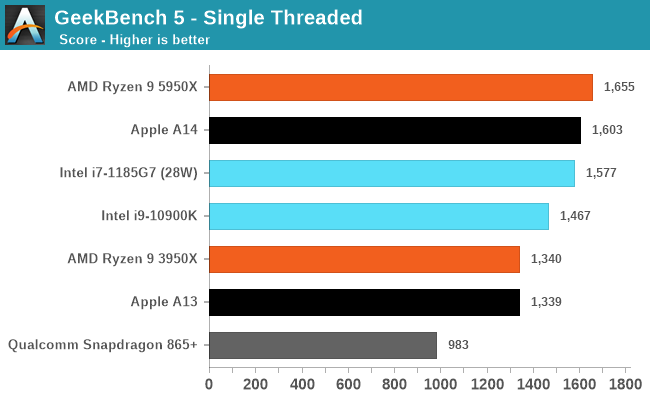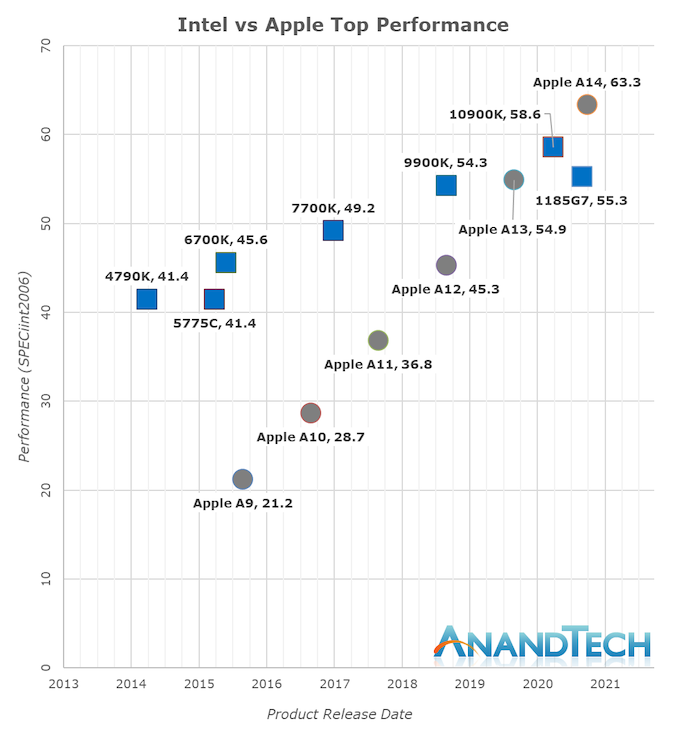Apple Announces The Apple Silicon M1: Ditching x86 - What to Expect, Based on A14
by Andrei Frumusanu on November 10, 2020 3:00 PM EST- Posted in
- Apple
- Apple A14
- Apple Silicon
- Apple M1
From Mobile to Mac: What to Expect?
To date, our performance comparisons for Apple’s chipsets have always been in the context of iPhone reviews, with the juxtaposition to x86 designs being a rather small footnote within the context of the articles. Today’s Apple Silicon launch event completely changes the narrative of what we portray in terms of performance, setting aside the typical apples vs oranges comparisons people usually argument with.
We currently do not have Apple Silicon devices and likely won’t get our hands on them for another few weeks, but we do have the A14, and expect the new Mac chips to be strongly based on the microarchitecture we’re seeing employed in the iPhone designs. Of course, we’re still comparing a phone chip versus a high-end laptop and even a high-end desktop chip, but given the performance numbers, that’s also exactly the point we’re trying to make here, setting the stage as the bare minimum of what Apple could achieve with their new Apple Silicon Mac chips.

The performance numbers of the A14 on this chart is relatively mind-boggling. If I were to release this data with the label of the A14 hidden, one would guess that the data-points came from some other x86 SKU from either AMD or Intel. The fact that the A14 currently competes with the very best top-performance designs that the x86 vendors have on the market today is just an astonishing feat.
Looking into the detailed scores, what again amazes me is the fact that the A14 not only keeps up, but actually beats both these competitors in memory-latency sensitive workloads such as 429.mcf and 471.omnetpp, even though they either have the same memory (i7-1185G7 with LPDDR4X-4266), or desktop-grade memory (5950X with DDR-3200).
Again, disregard the 456.hmmer score advantage of the A14, that’s majorly due to compiler discrepancies, subtract 33% for a more apt comparison figure.

Even in SPECfp which is even more dominated by memory heavy workloads, the A14 not only keeps up, but generally beats the Intel CPU design more often than not. AMD also wouldn’t be looking good if not for the recently released Zen3 design.

In the overall SPEC2006 chart, the A14 is performing absolutely fantastic, taking the lead in absolute performance only falling short of AMD’s recent Ryzen 5000 series.
The fact that Apple is able to achieve this in a total device power consumption of 5W including the SoC, DRAM, and regulators, versus +21W (1185G7) and 49W (5950X) package power figures, without DRAM or regulation, is absolutely mind-blowing.

There’s been a lot of criticism about more common benchmark suites such as GeekBench, but frankly I've found these concerns or arguments to be quite unfounded. The only factual differences between workloads in SPEC and workloads in GB5 is that the latter has less outlier tests which are memory-heavy, meaning it’s more of a CPU benchmark whereas SPEC has more tendency towards CPU+DRAM.
The fact that Apple does well in both workloads is evidence that they have an extremely well-balanced microarchitecture, and that Apple Silicon will be able to scale up to “desktop workloads” in terms of performance without much issue.
Where the Performance Trajectory Finally Intersects
During the release of the A7, people were pretty dismissive of the fact that Apple had called their microarchitecture a desktop-class design. People were also very dismissive of us calling the A11 and A12 reaching near desktop level performance figures a few years back, and today marks an important moment in time for the industry as Apple’s A14 now clearly is able to showcase performance that’s beyond the best that Intel can offer. It’s been a performance trajectory that’s been steadily executing and progressing for years:
Whilst in the past 5 years Intel has managed to increase their best single-thread performance by about 28%, Apple has managed to improve their designs by 198%, or 2.98x (let’s call it 3x) the performance of the Apple A9 of late 2015.
Apple’s performance trajectory and unquestioned execution over these years is what has made Apple Silicon a reality today. Anybody looking at the absurdness of that graph will realise that there simply was no other choice but for Apple to ditch Intel and x86 in favour of their own in-house microarchitecture – staying par for the course would have meant stagnation and worse consumer products.
Today’s announcements only covered Apple’s laptop-class Apple Silicon, whilst we don’t know the details at time of writing as to what Apple will be presenting, Apple’s enormous power efficiency advantage means that the new chip will be able to offer either vastly increased battery life, and/or, vastly increased performance, compared to the current Intel MacBook line-up.
Apple has claimed that they will completely transition their whole consumer line-up to Apple Silicon within two years, which is an indicator that we’ll be seeing a high-TDP many-core design to power a future Mac Pro. If the company is able to continue on their current performance trajectory, it will look extremely impressive.











644 Comments
View All Comments
rtharston - Thursday, November 12, 2020 - link
These benchmarks are all CPU only (with some memory bandwidth too, since the CPU can't do anything without memory...). All these figures are CPU only. Yes, Apple managed to make a CPU that is as fast or faster than Intel and AMD. Just read the article and you'll see how. They have more ALUs. They have more registers (thanks to ARM64). They have larger (and faster) caches across the board. All that adds up to a higher performance CPU.You are right about the dedicated silicon being better at other things though, so now imagine how much more performance Apple's devices will have when using these fast CPUs *and* the dedicated silicon to do other things.
daveedvdv - Thursday, November 12, 2020 - link
> My opinion is that using dedicated silicon for a specific task and not generic CPU computing is where almost ALL of the improved performance comes from.No. Neither SPEC nor GeekBench would take advantage of that.
Furthermore, the applications that Apple uses to boast about the CPU (not GPU) performance are thing like Clang, Ninja, and CMake, which wouldn't benefit from that either.
millfi - Wednesday, June 23, 2021 - link
Dedicated silicon is very fast and efficient when run specific Tasks with a high degree of parallelism, such as ML. But this cannot explain that M1 chips high IPC recorded in spec int. Because this benchmark runs general tasks which are written general CPU Instructions. If Apple could offload such a task to a dedicated circuit, that would be magic.melgross - Wednesday, November 11, 2020 - link
The M1 isn’t that much of an advance.BlackHat - Tuesday, November 10, 2020 - link
Guys, the main reason why I loved your website is because you dig in marketing footnotes, I don't know if you already read it (Aparrently no) but they are out and Apple claims that "the most powerful chip or the most power-efficient" is against their own 2018 MacBook, an 14nm i7 SkyLake with LPDDR3, no even against their last Ice Lake model, let alone Renoir (yes I know Apple doesn't have ryzen products) I don't know know if I missing something but I think that you ARM destroying x86 isn't going too far? Yes is power efficiency but it is that big difference to ignore all the performance lost?Greetings.
BlackHat - Tuesday, November 10, 2020 - link
And the single core claims are based in single core peak performance in "leadership industry benchmarks" whatever that means and an combination of JavaScript test and Speedometer (this last one I heard from you that was close to Apple) so, anyways we will wait for bench.Kilnk - Tuesday, November 10, 2020 - link
https://browser.geekbench.com/processor-benchmarkshttps://browser.geekbench.com/ios-benchmarks#
https://www.cpu-monkey.com/en/compare_cpu-apple_a1...
These are the benchmarks they are talking about.
Single core is faster than anything else in the consumer market. Yes. ANYTHING else.
Multicore lands just above the 9700KF.
BlackHat - Tuesday, November 10, 2020 - link
The think why people don't thrust Geekbench is because even they confirmed that old Geekbench benchmarks (basically 4 and older) were inaccurate due its dependency of bigger caches, meaning that CPU with bigger caches could beat other CPUs in short workloads (something that Geekbench those) but I can be wrong.name99 - Tuesday, November 10, 2020 - link
You mean Apple "cheat" by adding to their CPUs the pieces that make CPU's run faster, like a larger cache?OMG, say it isn't so!
The pretzels people twist themselves into when they don't want to face reality...
Just as a guide to the future, look to what really impresses those "skilled in the art" about this CPU. It's explicitly NOT the cache sizes; those are nice but even more impressive are the LSQ sizes, the MLP numbers (not covered here but in an earlier AnandTech piece) and the spec numbers for mcf and omnetpp.
Understand what those numbers mean and why they are impressive and you'll be competent to judge future CPUs.
BlackHat - Tuesday, November 10, 2020 - link
Talking about twist and you twist my comment, what Geekbench maker themselves said is due their bechmarks being of short run, CPUs with big caches show a big margin (no matter if Apple or other maker, in fact, they show how Samsung Exynos mongoose took advantage of this), for long workload the benchmark was useless.